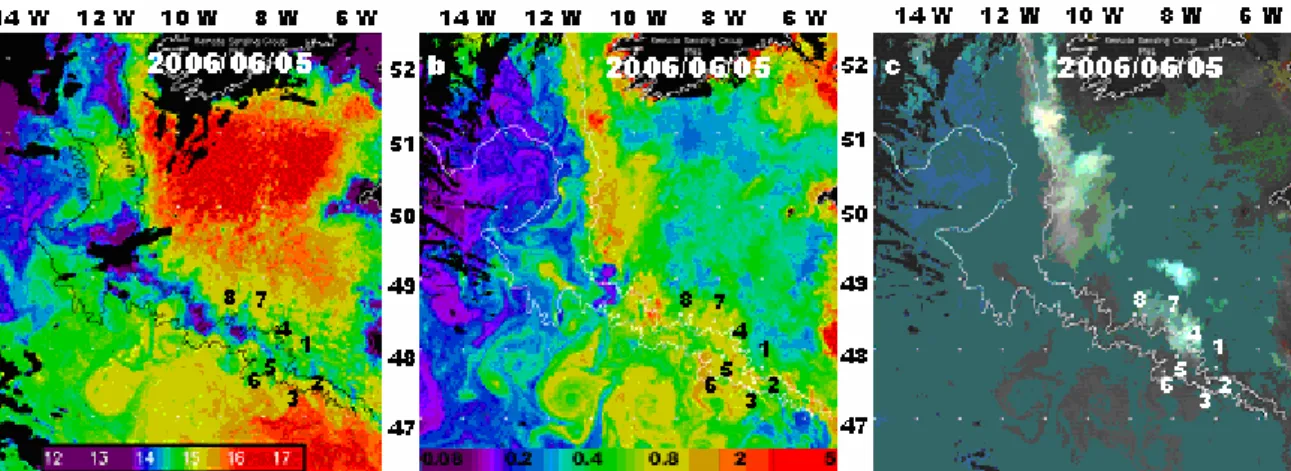Isobay12 - Brest, France – 3-6 May, 2010
Towards a comprehensive C-budgeting approach of a coccolithophorid
bloom in the northern Bay of Biscay: results from PEACE project
J. Harlay1, 2, A.V. Borges1, B. Delille1, K. Suykens1, C. De Bodt2, K. Sabbe3,N. Van Oostende3, A. Engel4, J. Piontek4, L. Chou2
1 Université de Liège, Unité d’Océanographie Chimique, Belgium
2 Université Libre de Bruxelles, Laboratoire d’Océanographie Chimique et Géochimie des Eaux,
Belgium
3
Université de Gand, Protistology & Aquatic Ecology, Belgium
4
Alfred Wegener Institute, HGF Young Investigators Group, Germany Email: Jerome.Harlay@ulg.ac.be
Keywords: coccolithophores; primary production; calcification; community respiration; Carbon budget
Introduction
During coccolithophorid blooms, carbon (C) cycling in the photic zone is driven by the production and the degradation of organic matter (primary production and community respiration), as well as the production and the dissolution of biogenic calcium carbonate (CaCO3). Organic and inorganic
metabolisms lead to a transfer of carbon to depth and both impact the flows of carbon dioxide (CO2) in
the water column and the CO2 flux across the air-sea interface. Furthermore, due to complex dynamics
of coccolithophores, the impact of metabolic C fluxes on CO2 fluxes is variable in time, depending on
the stage of the bloom development, and mainly on the ratio of calcification to primary production (CAL:GPP). Understanding and quantifying C cycling of coccolithophorid blooms in natural conditions is a prerequisite to correctly validate biogeochemical models aiming at predicting feedbacks related to ocean acidification, which incorporate knowledge obtained from perturbation laboratory experiments.
We carried out a trans-disciplinary cruise on board the R/V Belgica at the continental margin of the Bay of Biscay, in the midst of a coccolithophorid bloom, during which 14C primary production (GPPp), 14C calcification (CAL) and O2-based pelagic community respiration rates (PCR) were
determined in the water column.
Figure 1. a- AVHRR sea surface temperature (SST) in the northern Bay of Biscay, showing the location of the stations, the 200 m and 2000 m isobaths, b- MODIS chlorophyll-a (Chl-a) and c- Reflectance satellite images.
Results and discussion
The time series of remotely sensed parameters reveals a rise of SST accompanied by a shoaling of the thermocline to 25 m depth during the period of the cruise. This situation is favourable for
Isobay12 - Brest, France – 3-6 May, 2010
coccolithophorid development, as indicated by the elevated reflectance and moderate (~1 µg L-1) Chl-a concentration and nutrient exhaustion.
In agreement with Margalef’s Mandala (Margalef, 1997), the degree of stratification was hypothesized to control the biological processes and allowed the reconstruction of the succession phases of the coccolithophore-dominated bloom. Bloom aging was characterized by a decrease in Prymnesiophyte biomass relative to other phytoplankton groups. With increasing stratification from early coccolithophorid bloom stations (1-2-5) to the later stages (station 8), GPPp decreased as CAL increased over the shelf, leading to a significant CAL:GPPp ratio for later stages of the bloom. The aging of the bloom resulted in a lower GPPp:PCR ratio and an evolution from net phytoplanktonic community autotrophy to net heterotrophy.
A C-budget was computed along a gradient from the productive (station 2) to the high reflectance zone (station 8). Surface waters remained as a net sink for atmospheric CO2, although total alkalinity data
indicated that calcification had a large impact on surface carbonate chemistry. However, net autotrophy was only found for the early phase of the bloom (station 2) where the potential export was of the same magnitude as the aphotic C demand. In other cases, the C export was null or negative and insufficient to sustain aphotic C demand.
Conclusions
Our classical C-budgeting approach suffers from several caveats. Firstly, steady state is assumed but C production and degradation are decoupled in time and space, as well as biomineralization and dissolution. Secondly, the dissolved production (GPPd) is not considered here. The importance of GPPd and its potential fate to be transformed into transparent exopolymer particles (TEP) could constitute a significant C flux (12% of the POC, Harlay et al., 2009) to sustain the heterotrophic C demand in the twilight zone, as suggested by Koeve (2005).
The estimate of GPPd from the particulate nitrogen to carbon ratio in surface waters, based on the parameterization by Joassin et al. (2008) and the computation of C budget based on GPPtot (GPPtot = GPPd + GPPp) contributes to the budgeting of C fluxes to the twilight zone by providing a net export of the same magnitude as the aphotic demand (Harlay et al. in prep).
Acknowledgements
The authors would like to thank the officers and crewmembers of the R/V Belgica and the Unit of the North Sea Mathematical Models (Brussels/Oostende, Belgium) for their support in data acquisition. We are grateful to S. Groom, T. Smyth, and P. Miller for the AVHRR image. This study was financed by the Belgian Federal Science Policy Office in the framework of the PEACE project (contract no. SD/CS/03A/B) and by the Helmholtz Association (contract no. HZ-NG-102). AVB and BD are research associates at the FNRS. C. De Bodt was supported by a PhD grant from the EU FP6 IP CarboOcean project (contract no. 511176–2). N. Van Oostende received a PhD grant from the Institute for the Promotion of Innovation through Science and Technology in Flanders (IWT-Vlaanderen). This work is a contribution to the EU FP6 European Network of Excellence EUR–OCEANS (contract no. 511106-2) and EU IP CARBOOCEAN (contract no. 511176).
References
Harlay et al. (2009) Abundance and size distribution of transparent exopolymer particles (TEP) in a coccolithophorid bloom in the northern Bay of Biscay. Deep Sea Research part I.,
Joassin et al. (2008) A mathematical modeling of an Emiliania huxleyi coccolithophores bloom occuring in a mesocosm experiment. Biogeoscience discussions.
Koeve (2005) Magnitude of excess carbon sequestration into the deep ocean and the possible role of TEP. Marine Ecology Progress series. 291: 53-64
Margalef (1997) Our Biosphere, , Excellence in Ecology - Book 10, Inter-Research Science Publisher, O. Kinne Ed., Oldendorf/Luhe, Germany,176p
